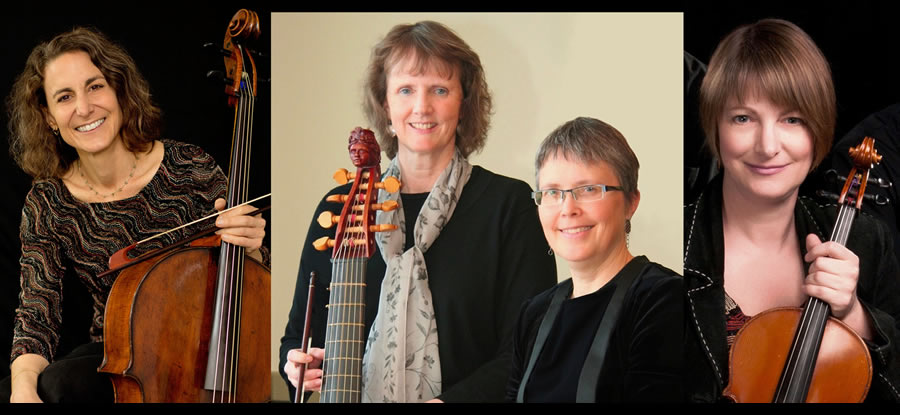It is a rare treat to review a local concert in my adopted home town! For their season finale, the Mallarmé Chamber Players brought a “British Baroque-ish” program to the intimate and lovely St. Matthew’s Episcopal Church in historic Hillsborough. The Colonial government constituted the Parrish in 1752 as the established church in the County of Orange. The current building dates from 1825-26. The Mallarmé’s imaginative program sampled the overlap transition between the Baroque and early Classical in eighteenth century London by native and visiting composers.
The performers were violist Suzanne Rousso, viola da gambist Gail Ann Schroeder, cellist Stephanie Vial, and harpsichordist Barbara Weiss. The latter instrument was a charming small rectangle with the keyboard along one side that fitted snuggly by the pulpit. Vial played two cellos, a standard four-string, and a five-string that was popular in England during this period.
The Baroque was represented by two selections by Henry Purcell (c.1659-95). From his Sonatas of III Parts, (1683), the Z.792, No. 3, in D minor, opened the concert. It is essentially in six movements alternating slow-fast: Sonata-Adagio-Canzona-Adagio-Poco Largo-Allegro. All four players performed this “trio sonata” with Rousso and Schroeder spinning the dense melodic line and Vial’s cello frequently doubling Weiss’s left-hand part. Even so, the string parts were much more independent than I had expected.
Weiss’ virtuosity was fully displayed in the Toccata in A. Her small harpsicord has a pleasing warm tone that was enhanced by the church’s acoustic. Dramatic flourishes and fast passage work were cleanly executed. The piece has had a checkered musicological identity. It was originally attributed to J. S. Bach as BWV. Anh. 178 but is now thought to be a 1657 Purcell work.
An important transitional instrumental work by Andrea Caporale (1700-46), who settled in London around 1735, came next. He played cello in many local performances such as those of Handel’s operas. At the time, the cello was much less popular than the viol, so Caporale composed his own pieces such as Sonata No. 4 in C, from a set of Six Solos for Two Violoncellos. It is in four slow-fast movements.
This was performed by Vial on her newly acquired five-stringed cello (with an extra e string) accompanied by Weiss’ fine keyboard support. Vial’s cello produced a full, rich sonority in the slow opening, dominated by a yearning melody and scope for tasteful trills and ornaments. A dance-like rhythm dominated the faster second movement with a striking phrase that was higher with each repetition. A melancholy, march-like slow movement led to a vigorously bowed finale. Her cello produced some impressive deep low notes.
Each half of the concert ended with light music by Viennese-born Andreas Lidl (c.1740-89), who had an impressive résumé. From 1769-74 he was a cellist in the Esterházy court orchestra beside being a fine baryton player. He is thought to have studied with Haydn. He composed music for wealthy amateurs featuring viola da gamba as well as baryton. His Divertimento No. 2 in G is typical. This featured viola da gamba. viola, four-string cello, and harpsichord. Its three, fast-slow-fast movements featured pleasant gamba melodies often supported by viola and cello. The finale gave players opportunities to show off fancy bowings as well as more exposure for the viola’s fine tone.
A work by once-renowned composer Carl Friederich Abel (1723-98) opened the post-intermission portion of the concert. Young Abel may have studied under J.S. Bach at St. Thomas school in Leipzig. In London, he was close friends with Bach’s eleventh son J. C. Bach and jointly established the Bach-Abel Concerts. He is regarded as one of the last great viola da gamba virtuosos. Among his many gamba students was Lady Pembroke, whose husband played the cello.
This mastery was evident throughout Abel’s Duetto No. 11 in G for viola da gamba and cello, coming from the Second Pembroke Collection. It is in three movements: Poco allegro, Un poco adagio, and Presto. In the opening movement, Schroeder spun the melody above Vial’s four-string cello accompaniment before the two exchanged roles. Vial’s cello wove a sad melody in the second movement before it was taken up by the gamba. The finale featured a wonderfully bouncy theme that gave Vial’s cello a showy spotlight before closing.
An obscure but militant advocate for the neglected viola efforts came next. Canterbury-born William Flackton (1709-98) was a choir boy in the cathedral at age nine. In addition to a successful career as a bookseller and publisher, he maintained a musical life as a gifted amateur organist, violist, and composer. His Sonata No. 4 in C from his Six Solos: Three for a Violoncello and Three for a Tenor (a Viola), Accompanied Either with a Violoncello or Harpsichord, Op. 2, came next. It is in four movements: Grazioso Largo, Allegro, Siciliana, and Minuetto I & II.
Violist Rousso prefaced her performance saying she would not try to play all of the many appoggiaturas and trills Flackton spread throughout his score. Displaying fine tone and color, she delivered quite a sample her technique! She was ably supported by Vial’s agile four string cello and Weiss’ gossamer keyboard playing. The second movement featured strong, rhythmic themes and plenty of ornamentation. The third had trills aplenty while the last exploited the viola’s lovely middle range and the lower range of both strings.
A melodious Divertimento No. 7 in G by Lidl ended the concert, leaving the audience in a good mood. The printed program listed only two of its three movements which are Allegro, Andante, and (Allegro). It called for all four performers. Schroeder and Rousso traded lively melodies in the opening movement. A slowly spun gamba melody and Weiss’ fine harpsichord chords were highlights of the middle, and impressive fast bowings brought the concert to a very satisfying end.
The Mallarmé Chamber Players will repeat this performance in Asheville as a part of the Asheville Baroque series on Sunday, June 2. See our sidebar for details.











